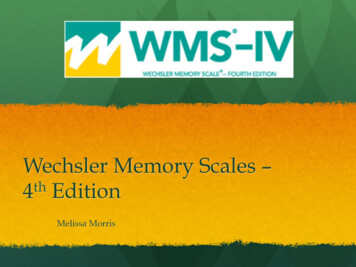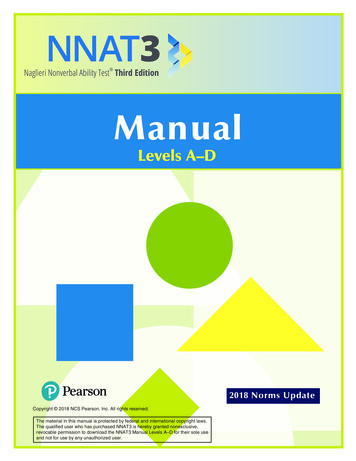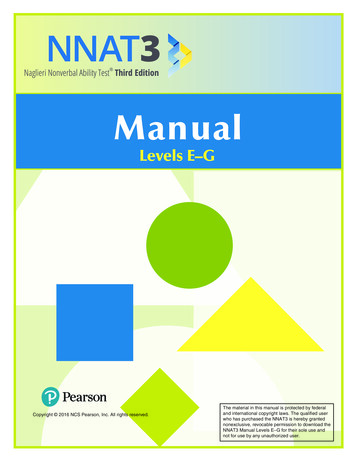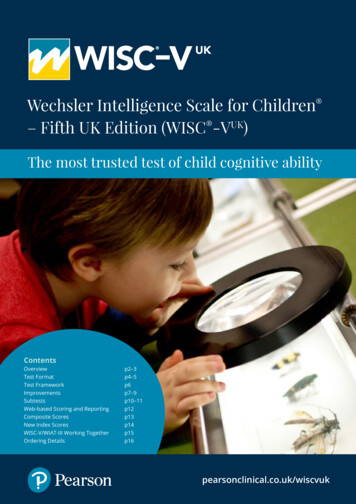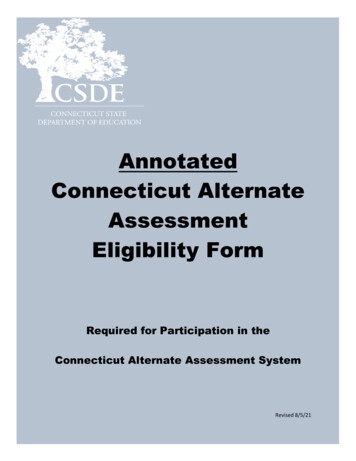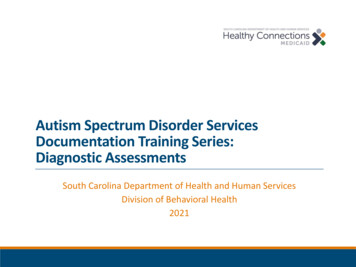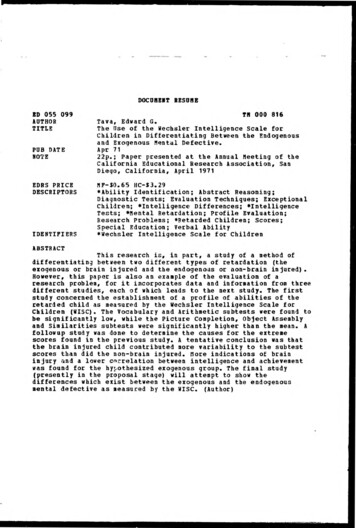
Transcription
DOCUMENT RESUMEED 055 099AUTHORTITLEPUB DATENOTEEDRS PRICEDESCRIPTORSIDENTIFIERSTM 000 816Tava, Edward G.The Use of the Wechsler Intelligence Scale forChildren in Differentiating Between the Endogenousand Exogenous Mentdl Defective.Apr 7122p.; Paper presented at the Annual Meeting of theCalifornia Educational Research Association, SanDiego, California, April 1971MF- 0.65 HC- 3.29*Ability Identification; Abstract Reasoning;Diagnostic Tests; Evaluation Techniques; ExceptionalChildren; *Intelligence Differences; *IntelligenceTests; *Mental Retardation; Profile Evaluation;Research Problems; *Retarded Children; Scores;Special Education; Verbal Ability*Wechsler Intelligence Scale for ChildrenABSTRACTThis research is, in part, a study of a method ofdifferentiating between two different types of retardation (theexogenous or brain injured and the endogenous or non-brain injured).However, this paper is also an example of the evaluation of aresearch problem, for it incorporates data and information from threedifferent studies, each of which leads to the next study. The firststudy concerned the establishment of a profile of abilities of theretarded child as measured by the Wechsler Intelligence Scale forChildren (WISC). The Vocabulary and Arithmetic subtests were found tobe significantly low, while the Picture Completion, Object Assemblyand Similarities subtests were significantly higher than the mean. Afollowup study was done to determine the causes for the extremescores found in the previous study. A tentative conclusion was thatthe brain injured child contributed more variability to the subtestscores than did the non-brain injured. More indications of braininjury and a lower correlation between intelligence and achievementwas found for the hypothesized exogenous group. The final study(presently in the proposal stage) will attempt to show thedifferences which exist between the exogenous and the endogenousmental defective as measured by the WISC. (Author)
THE USE OF THE WECHSLER INTELLIGENCE SCALE FOR CHILDRENIN DIFFERENTIATING BETWEEN THE ENDOGENOUS ANDEXOGENOUS MENTAL DEFECTIVEEdward G 0 TavaUniversity of the PacifizSchool of EducationCalifornia Educational Research AssociationSan Diegoc CaliforniaAprils 1971
Abstract:Much research has been done in the area of mentalretardation. Houever, because the majority of special educationprograms have attempted to use nearly the same teachingmethods for all retarded children, very little researchhas been done in the area of differential diagnosis of thevarious types of retardatione This paper is, in part, astudy of a method of differentiating between two differenttypes of retardation he exogenous or brain injured and theendogenous or non-brain injured), However, this paper isalso an example of the evolution of a research problem, forit incorporates data and information from three differentstudies, each of which leads to the next study,The first study concerned the establishment of a profileof abilities of the retarded child as measured by theWechsler intelligence Scale for Children (WISC)0 One hundredretarded children were randomly selected for the study0The mean scaled score for each of the eleven subtexts of theWISC (omitting Mazes) were found. The Vocabulary and Arithmetic subtests were found to be significantly lower than themean scaled score for the entire population, while the PictureCompletion, Object Assembly and Similarities subtests weresignificantly higher than the mean.A blowup study was done to determine the causes forthe extreme scores on the WISC as found in the previousstudy, From an investigation of the variance of the subtestscaled scores, two groups of children were further studied.One group,, labeled as high variability, showed six timesthe rate of brain injury as the loe variability group,Furthermore, the low variability group yielded a highercorrelation coefficient (ten) between I.and achievementthan the high variability group ( ,,41), Although Udedifference was not significant at the 005 level, it servedto point out some differences between mentally retardedchildren. A tentative conolusion from this study was thatthe high variability group contained a high percentage ofexogenous (brain injured) children, thus accounting far thehigh indication of brain injury and the low correlationbetween I.Q0 and achievement, The low variance groupappeared to be composed mostly of endogenous defectives(non.train injured). However, this conclusion demanded amore thoroughly controlled study to be substantiated.The final study is currently in the proposal state.This study will attempt to show the differences which existbetween the endogenous and exogenous mental detectives asmeasured by the WISC. Tentative hypotheses are that theexogenous retardates will score higher than the endogenousdefectives on the verbal tasks of the eISC, while theendogenous child will show superior skills on tasks requiringmemory, visual perception, visual-motor ability and othernonverbal skills* Furthermore, the exogenous child should
show more intertest and intratost variability than does theendogonous child,Thus it is felt that there exists significantdifferences between the exogenous and endogenous mentaldefective which supports the conclusion that there is aneed to develop two separate teaching methods and educationalprograms, including separate classrooms, for the endogenousand exogenous mental defectives,
STUDY # 1. TEST PATTERNS OF MENTALLY HANDICAPPED CHILDREN ONTHE WECHSLER INTELLIGENCE SCALE FOR CHILDRENProblem: The main purpose of this research is to determine ifa specific pattern of scores exists for children diagnosed asmentally handicapped, According to a previous study done byGallagher and Lucite, (1961) some definite patterns of scoreson the Wechsler Intelligence Scale for Children were found, Usingthe population of a previous study as well as test scores foundby other researoherss they found the Vocabulary, Information andArithmetic subtexts generally low for mentally retarded children;while high scores were found on the Picture Completion andObject Assembly subtests, As can be seen: retardates do pooreron the abstracts verbal sections than on the more concrete,non-verbal subtests, No specific pattern of scores was found forchildren of average intelligence,Method: Four groups of 100 test protocols each were randomlyselected from existing psyohological reports of the SpecialEducation Department s Kalamazoo Public Schools, All childrenmere referred for testing because of learning problems. Therewere 277 boys and 123 girls comprising the entire group,Afurthor breakdown shows 201 (50%) male whites 76 (19%) maleblack,. 76 (19%) female whites and 47 (12%) female blacks, Thetong* of age was from 5 to 15 years with a mean age of 9.76.Average intelligence using the WISC was Verbal IA. 79.Performance I.Q. 79, and Full Scale I.Q. 77.The four groups were divided acoording to the following
classification:Verbal Performance & Full Scale I.Q.GroupGroup 1 (mentally defective) I.Q. below 70Group 2 (borderline)Ie,Q0 70 . 793 (dull normal)Group 4 (average)I.Q. 80 — 69GroupI.Q, 90 — 119The scaled scores for each of the regularly administeredeleven subtests of the WISC were totaled for each group. Meansfor each subtext were found. T-tests were run between each ofthe eleven subtests and the mean subtext score for each groupto determine it certain subtests deviated significantly fromthe mean and thus develop a pattern of scores for that group BumatiTABLE 1MEANSCALED SCORESGroup ilarities4.39Vocabulary3.31Digit SpanGroup 2 Group 3 Group 886672561823081is2236.162.42&44065Picture Completion5.217,028.33Picture Arrangement30956.197.67Verbal Subtotal55065100249049
Table I continued:Group / Group 2 Group 3 Group 4Block Design4,406,527,899.76Object Assembly4.877.067.719.69.-.4490 SAE Zak22,433206738,96jalCodingPerformance Subtotal4 111.0.0.011111111 0110040,48,41 Median4.1560127.599037TABLE 2T TEST (mean vs subtext score)Group 1 Group 2Group 3Information-0037-.3068**.4.20.*Group 4.30014 04,Comprehension 0037-1032 0070 ies 2005* 3074** 3,67**4.3026"Vocabulary4- .4068" 3.684" .4.40**-2,52**Digit Span.4037 0063 10 52 0,04Picture Completion 9063"440004"4 3039"Picture Arrangement00007 0035 0,13Block Design 1005 1045 1030Object Assembly4 1037 4.21*, 0.55 1000Coding-1005 2000f0.4014-00961032.3.391413065"
Table 2 continued:** sign at the .01 level (2326)* sign at the .05 level (1,64)Discussions, The results as shown in Table 2 Indicate a definitepattern of scores for children of mentally handicapped intelligence,Picture Completion in primarily the highest score on the testprotocols of these children, The Object Assembly subtest alsodeviates significantly above the mean, The Vocabulary and Arithmetic subtests fall below the mean. A fifth subtest, Similarities.shots tendencies toward deviation above the mean, As can be seen %the subtests which deviate below the mean are the most abstract,verbal and academically oriented subtests * while the two deviatingabove the mean are concrete, nonverbal and non—academicallyoriented, The Similarities subtest appears out of order withthe above profile for the retarded, However, further analysisshows that many of the children who scored high on this subtestwere able to do so by use of functional and concrete approachesrather than using abstract concepts, Furthermore, this subtestat the lower level does not measure similarities or verbal conceptformation, but instead measures analogies at a simple level.Therefore, the relatively high scores on Similarities representsthe level of concrete verbal abilities in mentally retardedchildren,Because Group 1 (mental defectives) and Group 2 (borderlinedefectives) do not differ a great deal in intellectual level, itis not surprising to see many similarities between the profilesof Groups 1 and 20 In fact, there are six significant deviations,
positive and negative, from the average score for the childrenof Group 2, Of these six deviations, five of them directlycorrespond to the deviating scores of the first group, Theadditional deviation occurs on the Information subtest, anotherverbal, academic oriented subtest This subtext likewise deviatesbelowthemean scores,The fact that Groups 3 and 4 have many of the same deviationsas the other groups does not holp establish an individual patternof abilities and disabilities for the mentally defective However,it is felt that the population of mentally retarded children inthis study is a typical sample'while the population of childrenwith average intelligence is considered to be highly atypical.This group is a clinical population of non-learners, They arechildren who are unable to learn under normal classroom situations,Summary: The basic purpose of this research is to help establisha profile of subtext scores on the WISC for mentally handicappedchildren, A profile was established which found relatively highscores in the more none-verbal'concrete and non-academic subtests(Picture Completion and Object Assembly) and relatively low scoreson certain verbal'abstract and academic oriented subtests(Vocabulary and Arithmetic), A similar profile was found forborderline retarded children which was felt to reflect theirretardation and accumulation of varying degrees of disabilities.The profile for the "average" children unfortunately indicatestheir disabilities in the area of academic learning and does notshow a true profile of abilities for children of averageintelligence.
STUDY # 2: A COMPARISON OF MENTALLY HANDICAPPED CHILDREN WHOEXHIBIT HIGH OR LOW VARIABILITY OF THE SUBTESTS ON THE WECHSLERINTELLIGENCE SCALE FOR CHILDRENThe main purpose of this research is to determine ifProblem:mentally retarded children who differ in the amounts of variabilityon the Wechsler Intelligence Scale for Children also differ onother test measures, In a previous study, the author establisheda profile of abilities for the mentally retarded child as testedby the WISC. This research showed the retarded child to be higheston the non-verbal, concretes non-academic subtests of the WISC(Picture Completion and Object Assembly) and lowest on the verbalabstract and academic oriented subtests (Vocabulary and Arithmetic:,Upon examination of the data of this study, it was found thatsome subjects had a very even profile of scores on the WISC„while others had marked deviations. It was hypothesized that thesubjects whoce WISC profiles were even would differ from thesubjects with many deviations on measures of brain injury andachievement.Method: Agroup of 100 subjects from a previous study was used.Using the WISC protocol for each of thee subjects the variability,In the form of the standard deviation of subtest scores, wascomputed The moan standard deviation for this group was computedat 14.44 with a S.D. of 4.22. The subjects were then separatedinto three group's group one consisted of the subjects with highvariability (one standard deviation above the moan), group twoconsisted of those subjects with a low amount of variability (one
standard deviation below the mean), while group three consistedof the subjects with an average amount of variability (plus orminus one standard deviation from the mean), Group one consistedof 19 subjects as did group two, Group three (N 62) was not usedin this study.Medical records of the subjects of groups one and two werethoroughly checked for evidence of medical diagnosis of braininjury, No statistical tests were used to compare the incidenceof brain injury between these two groups. Only the total ofsuch incidences were tallied.Each of the subjects was also given the Wide Range AchievementTest (WRAT)0 Only 18 of the subjects of group one and 17 subjectsof group two were available for tasting, The mean standard scores(S,S.) of the Spelling, Arithmetic and Reading sections of theWRAT were treated as an Achievement Quotient (A.Q.) and compared withthe I.Q. score of each subject. A Pearson Product-MomentCorrelation Coefficient was found for each group with a z testrun between the correlation coefficients,Resups:Incidence of brain injury in case history:Group one (high variability)6Group two (low variability)1 casecasesCorrelation coefficient between achievement (A.Q.) andintelligenceGroup one2E22R.112No1817Mean I.Q.5901757041
Mean A.Q0aGIOUD oneGroup two65,24 04167,53 .77z is 10 58 (Not significant at ,05 level') a value of 1096 was needed for significance at the 005 levelDiscussion: As can be seen from the previous results, group one(high variability) had six inoidemes of brain injury out of 19subjects, while group two (low variability) had only one caseout of 19, Although this is not considered significant evidence,it is felt that it is at least irdicating a trend, That is, itappears that more brain injured children were contained in gropone than in group two,Also, from the above results, group two had a'highcrcorrelation between intelligence and achievement ( 077) than didgroup two( Al). Although the difference between these twocorrelation coefficients is not statistically significant, it isfelt that this difference points to an important educationaltrend, That is, group two appears to be achieving closer to theirability than group One,Summary;, The purpose of this Study is to determine if a groupof 19 subjects who showed little variability on the WI5C woulddiffer on other measures from a group of 19 subjects wit., highvariability. A cheek through the complete medical histories ofthe subjects revealed six caset of brain injury in group one(high variability), but only one case in group two (low variability),Furthermore, a correlation coefficient of 077 was found for
group two when intelligence and achievement wore compared.Group one showed a correlation of only ,41, thus indicatingthat group two was achieving closer to their ability than wasgroup one.A tentative hypothesis is that group one achieved at alower rate because of a higher occurance of brain injury.Furthermore, since group one had high variability between thesubtests of the OISC, a high medical incidence of brain injuryin their case histories and a low level of achievement whencompared with intelligence, it is, therefore, hypothesized thatgroup one consisted primarily of brain-injured retarded children(exogenous), Also, it is hypothesized that group two consistedprimarily of non brain injured (endogenous) mental defectives,However, further research is needed to substantiate thesehypotheses.
.STUDY # 31 THE USE OF THE WECHSLER INTELLIGENCE SCALE FORCHILDREN IN DIFFERENTIATING BETWEEN THE ENDOGENOUS AND EXOGENOUSMENTAL DEFECTIVEIntroduction: Proposed Dissertation StudyFor many years,special education programs for the educable mentelly retardedhave attempted to use similar teaching methods for all retardedchildren, These methods were aimed at helping the non-brain injuredretardates and adve.eated the use of a large variety of learningexperiences with ri high level of stimulation (Kirk, 1963, pp,120421; Frankel et al, 1966,pp. 9-11.)The main concern of theeducator has been to differentiate between the retarded and thenon retarded child with secondary concern given to the classificationof trainable and educable retardation, Little or no concern hasbeen devoted to further differentiation within the group ofE.H.R. children.Statement of theproblem:The problem to be investigated in thisresearch is to identify those measured skills contained withinthe Wechsler Intelligence Scale for Children (WISC) which willdifferentiate the endogenous type mental defective from theexogenous retardate,Rationale: Theneed for devising a method of differentialdiagnosis for the mentally retarded is to enable the educator tomore effectively group these exceptional children for the purposeof instruction, Historically, it has been assumed that E.H.R.children composed a homogenous group by virtue of having.
homogenous I.Q. scores. However, there has been some evidence(Martinson and Strauss„ 1940) that indicated that the erogenous(brain-injured) retardate requires a different educational programfrom the endogenous (nonebraineinjured) mental defecGive, intheir study, Eartinson am Strauss (1940) found the endogenous childto be very slow in learning new behaviors and new tasks, but veryable to work on the same task for long periods of time„ Theexogenous type children were found to be lacking in the skills ofattention, They were more disorganized, incoherent and distract able. than the endogenous child, Therefore, from paw; experience,it has been evident that there is a need for two types of programsfor the mentally retarded However, the current trend is for asingle grouping of educable mentally retarded children forpurposes of educational instruction.It is felt that the main reasons for homozonous grouping ofeducable mental retardatee have been the lack of adequate organizatlon to provide two separate programs for retarded childrenand the lack of adequate instruments and methods of differentiatingbetween the two groups of mental defectives. It is also feltthat the former is the easier to remediate.Since a medical diegnosis has been required in the pest formaking a discrimination between the endogenous and the exogenousmental detective, most educational institutions have found itdifficult to finance such a program of diagnostics, However,many school systems employ specialists, such as educational,school or clinical psychologists who are qualified to use alarge nrmber of test instruments and to make certain educationaland/or psychological diagnoses, Thepsychologistemployed in the
school should be capable of differentiuting between the endogenous and exogenous type mental defective, It is also feltthat with proper use, any number of test instruments would bevalid for use as described above0 However, because of the rangeof abilities tested and its widespread use and familiarity, theWechsler Intelligence Scale for Children (WISC) was chosen forthis study. The method of differential diagnosis is the remainingproblem to be investigated in this study0021114tiqn of termei1. Endogenous mental defectives A medical diagnosis hasshoWill (1) the presence of mental deficiency among the members ofthe immediate family, (2) the absence of significant factors inthe birth and developmental history, according to the case record,and (3) the absence of neurological signs of each of these subjects.2. Exogenous mental defective: Each subject in this classifiecation hats been medically diagnosed as having: (1) no evidence ofmental deficiency in the members of the immediate family, (2) ahistory of pre natal, natal or post-natal injury to the brain,either of a traumatic nature or due to an inflammatory process& or(3) the presence of neurological signs of brain lesion. Thesedefinitions are similar to those used by Frazeur and Hoakley (190)03. Strauss treatment method: According to Martinson and Strauss(1940), the exogenous child requires a treatment program whichUtilizes a variety of approaches, such that the most proper approachcan be used depending upon the pattern of damage resulting fromthe organic defect.4. Traditional treatment method: Martinson and Strauss (1940)
.also state that the endogenous child learns at a much slower ratethan does the normal child. Therefore, it is nocessary to trginthe child intensively, using carefully selected materials, butwith a very basic method, Since most programs view the retardedchild as if he were of the endogenous type and prepare his programas such, the method of teaching the endogenous child will beconsidered as the traditional treatment method.Limitationspf this study: This study is faced with the limitationscaused by the definitions of the endogenous and the exogenous typomental defective. By using a medical approech for differentiatingbetween the endogenous and the exogenous types of deficiency,certain inconsistencies of diggnosis will be present. ?or example,parental pressure could affect the final diagnosis, therebycausing an artificial increase in the number of brain-injured(exogenous) retardates. Furthermore, there exists considerablevariability of competency for such a diagnosis within the medicalprofession.Method:The 4ISC protocol of two hundred subjects were seleretedInto two groups, the endogenous and the exogenous mental defective *The results of each of the eleven subtests of the WI3C were usedfor each group. The scaled scores of each of the following eubteetswere used: Information, Comprehension, Arithmetic, Similarities,Vocabulary, Digit Span, Picture Completion, Picture Arrangement,Block Design, Object Assembly and Ceding Certain subtests scaledscores were combined totraits.yield composite scores measuring commonThe scaled scores of the followingsubtests were added
to yield a single score measuring a specific treit: Informationand Picture Completion (alertness); Comprehension and PictureArrangement (comprehension of social situations); Similaritiesand Block Design (concept formation); Information, Comprehension,Similarities and Vocabulary (verbal comprehension); Block Design,Object Assembly and Coding (visual-motor organization); andArithmetic, Digit Span and Coding (concentration).T-tests were run comparing the two groups on each of thesesix measures, Differences were considered significant at the .01level. The following hypotheses wore tested using these data:Hypothesis laThere are no differences between the endogenousand exogenous child as measured by the total of the verbal comprehension pubtests of the WISC. (Information, Comprehension, Similarities, and Vocabulary.)Hypothesis 2: There are no differences between the endogenousand the exogenous as measured by the total of the visual-motororganization cluster of the WISC (Block Design, Object Assembly,and Coding subtests).Hypothesis 3: There are no differences between the endogenousand the exoeenous as measured by the total of the Information andPicture Completion subtests of the WlSC (alertness cluster).Hypothesis k: There are no differences between the endogenousand the exogenous as measured by the total of the Comprehension andPicture Arrangement subtests of the WISC (comprehension of socialsituations.Hypothesis 5: There are no differences between the endogenousand the exogenous as measured by the total of the similarities andBlock Design eubtests of the WISC (concept formation).
15.Hypothesis 6:There are no differences between the endogenousand the exogenous as measured by the total of Arithmetic, DigitSpan and Coding subtests of the W1SC (Concentration).The verbal 1.4. and the performance I.e. of each subject wasused for the next part of the study. The difference between theVerbal I.Q. and the Performance IA. of each subject was computedby subtracting the Performance 1.40 from the Verbal I.Q. A t-testwas run comparing the two groups of subjects on this measure of thedifference between verbal and nonverbal abilities. Significanceagain was sought at the 001 level. The following hyuothesis wastested using these data.Hypothesis. 7: There are no differences between the endogenousand the exogenous as meesured by the difference between the Verbal10Q0 and the Performance 14Q0 of the WISC(VIQ PIQ)The variance of the scaled scores for the eleven subtcsts ofthe WISC were computed for each subject. The value of the variancewas used as an index of intratost variability, A tetest was runcomparing the two groups on this measure. A .01 level of significance was sought. The following hypothesis was tested using thesedata:Hypothesis 8: There are no differences between the endogenousand the exogenous as measured by an index of intrateet variabilityOf the 'WISC.Lastly, a measure of tntertest variability was computed foreach subject. Each time a subject completed a difficult problemor answered a difficult lima after he had previously failed aneasier one (scored as zero) one point was tabulated. This wasdone with all of the subtests except Digit Span and Coding. For18
theDigit Span subtest, an inconsistency was scored when thesubject passed an item on the second attempt after failing thefirst, No measure of inconsistency was attempted for the Codingsubtest, Ifaftera subject passed two or more items in successionfailing the easier item, a score of only one point wascounted.Only the inconsistenciesof failures were scored and summedfor the measure of intertest variability. A t-test was then runcomparing the endogenous and the exogenous groups. A .01 level ofsignificance was sought. The following hypothesis was tested usingthese data:Hypothesis 9: There are no differences between the endogenousand the exogenous as measured by an index of the total intertestvariability of the WISC.Expected Results: In summary of the previous studies dealing withendogenous and exogenous mental defectives, it appears that theendogenous.exogenous classifications can be differentiated accordingto the following: the endogenous child has been found to besuperior to the exogenous child on tasksrequiring concept formation,visual perception, visual—motor ability, memory and othernonverbalskills. The exogenous defective appears to be generally superiorto the endogenous child on verbal tasks. The exogenous child alsoappears to be more alert and more sociable. Furthermore, theexogenous child should show considerable more intertest and intra.test variability than does the endogenous child.Relating to the present study usingthe WISC, the literaturereview suggests that the endogenous child should be superior to theexogenous on those subtexts measuring concept formation (Similarities
plus Block Design) and visual motor organization (Block Design,Object Assembly and Coding). The exogenous child should prove tobe superior on those subtexts measuring verbal comprehension(Information, Comprehension, Similarities and Vocabulary); andalertness (Information, and Picture Completion) and comprehensionof social situations (Comprehension and Picture Arrangement).Furthermore, the difference between the Verbal I.Q. and thePerformance I.Q. should also indicate the verbal superiority ofthe exogenous group. Lastly, the exogenous group should alsoshow greater intertest and intratest variability than theendogenous group.
REFERENCESBaroff, G.S. WISC Patterning in Endogenous Mental Deficiency,ecarlaoftlentitlataancz,19590 64, 402-485.Wil.1.4Joij.EBeck, 11.S0 and Lam, ILL. Use of the WISC in Predicting Organicity Journakof ClInioalleyohologY, 1955, 13. 0 1541570Benaberg, G.J, A Test for Differentiating Endogenous and Exogenous.efacionsato 54Mental Defectives,aaiLvrisi2L2I22.LLenititik1950, 502.5060Bijou S.W The Psychometric Pattern Approach as an Aid to CnnicalMental Deficiency,46,Analysis - A Review. American Journal of1942, 354-3620Cassel, R.H. Relation of Design Reproduction to the Etiology ofMental Deficiency J urnal of Connultingjjal421262, 139 1949,Dolphin, J,E and Cruickshank, W,M. Pathology of Concept Formationin Children with Cerebral Palsy American Journal of Mental2111121.00a, 1952, 56 386.392,,Doll, E.A. Influence of Environment and Etiology on Social Competence, American Journal of MentiaLlifisiem, 19458 50, 89-.94Doll, EGA Practical Implications of the Endogenous.ExcgenousClassification of Mental Defectives American Journal of Mentalaugunt. 1946. 50, 503.511.therankel, M.0.0, Rapp, F.W. and Smith, Mao Functional Teaching ofte taRetarded Springfield, Illinois: 5;3177C0 Thomas.s er eFrazeur, H0A, and Roakley, Z,P. Significance of Psychological TestResults of Exogenous and Endogenous Children, American J2IlizaaplazeIll.Rulgaggi. 51, l947, 384.3880Gallagher, 6140 and Lucite, L.J. Intellectual Patterns of GiftedCompared with Average and Retarded Exualamel
Wechsler intelligence Scale for Children (WISC) 0 One hundred . visual-motor ability and other nonverbal skills* Furthermore, the exogenous child should . show more intertest and intratost variability than does the endogo
